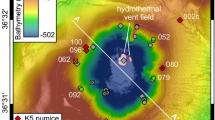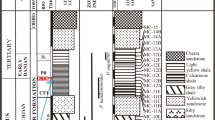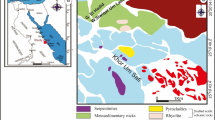Abstract
Hydrochemical analysis results suggest four different water types: bicarbonate dominant water (facies-I), sulfate dominant cold brine water (facies-II), sodium-bicarbonate dominant thermal water and thermal and mineralized water (facies-III), and sulfate–chloride dominant thermal and mineralized water (facies-IV). The mineral content/salinity of the water is related to the ions that these waters dissolve from the minerals on the rocks during infiltration and circulation in the saturated zone. Gypsum cover units that exist on the granitoids in the region is the main factor for the ion increase in the facies III geothermal water similar to the cold brine water (facies II). Isotopic analyses indicate that the thermal springs (Dutlu bath spring, Ayaş bath well, Çoban bath well and Kapullu bath spring) are of meteoric origin and receive recharge from precipitation in the Beypazarı granitoids and around gypseous formations with elevations of about 950–1,150 m. Karakaya bath well and Ilıca bath spring thermal water points are recharged from the Bilecik limestone hills, Tekke volcanics and İncedoruk Formations. Karakoca mineral spring of thermal and mineralized water is recharged from out of the study area. According to oxygen-18 (SO4 2−) and sulfur-34 (SO4 2−) contents, sulfate in water samples from Ayaş and Dutlu resorts as well as Çoban bath is derived from the gypsum of Kirmir Formation as the primary source. Sulfates of the Kapullu bath water and Karakoca mineral water originate from secondary sources such as pyrite oxidation and bacteriological reduction.











Similar content being viewed by others
References
Açıkgöz S, Akıllı H, Kurtuluş O, Küçük M, Hökelekli E, Taşkıran L, Şerifoğlu BI, Yıldırım G (2007) Investigation report of Çobanhamamı-Çağa-Güdül (Ankara) geothermal field, MTA Report, Ankara (in Turkish)
Albu M, Banks D, Nash H (1997) Mineral and thermal groundwater resources. Chapman and Hall, London 447 pp
Allen DM, Grasby SE, Voormeij DA (2006) Determining the circulation depth of thermal spring in the southern Rocky Mountain Trench, south-eastern British Columbia, Canada using geothermometry and borehole temperature logs. Hydrogeol J 14:159–172
Arnorsson S, Gunnlaugsson E, Svavarsson H (1983) The chemistry of geothermal waters in Iceland III, chemical geothermometry in geothermal investigations. Geochim Cosmochim Acta 47:567–577
Canik B (1973) Geology–hydrogeology investigation of the Ayaş resort and bath. Min Res Explor J 80 (in Turkish)
Clark I, Fritz P (1997) Environmental isotopes in hydrogeology. Lewis Publishers, London 328 pp
Çağlar KÖ (1947) Mineral waters and baths of Turkey, Series B, No.11, Fascicle 1. Mineral Research and Exploration (MTA) Publications, Ankara (in Turkish)
Çelik M (2007) Evaluation of origin of the Ayaş-Beypazarı geothermal waters with sulfur isotopes, Central Anatolia, Turkey. In: International symposium on advances in ısotope hydrology and ıts role in sustainable water resources management, (IHS–2007), Vienna, Austria, 21–25 May 2007 (unpublished)
Çelik M, Kadıoğlu YK (2007) Nature of geothermal waters around Ayaş-Beypazarı (Turkey): geochemistry and isotopic evaluation. In: Second ınternational cenference on geo-resources in the Middle East and North Africa, Grmena-II, pp 455–466
Çelmen O (2008) Hydrogeochemical and isotopic investigation of the thermal and mineralized springs between Sivrihisar and Beypazarı region (in Turkish). PhD Thesis, Ankara University, Graduate School of Natural and Applied Sciences, Ankara, 239 pp
Çetin A (2006) Hydrogeologic investigation of Ayaş, Karakaya and Ilıcaköy thermal waters. MSc Thesis, Graduate School of Natural and Applied Sciences, Hacettepe University, Ankara
Diker S (2005) Hydrogeological investigation of the Kapullu bath and around (Beypazarı) (in Turkish). MSc Thesis, Ankara University, Graduate School of Natural and Applied Sciences, Ankara, 147 pp
Diker S, Çelik M, Kadıoğlu YK (2005) Formation and hydrogeological characteristics of the Kapullu bath spring (Beypazarı/Ankara) (in Turkish). II. National ısotope techniques symposium on hydrology, General Directorate State Hydraulic Works, Gümüldür-İzmir, pp 195–208, 26–30 September 2005
Diker S, Çelik M, Kadıoğlu YK (2006) Fingerprints of the formation of geothermal springs on the granitoids: Beypazarı-Ankara, Turkey. Environ Geol 51(3):365–376
Dowgiallo J, Halas S, Porowski A (2005) Isotope temperature indicators of thermal waters in south-western Poland. In: Proceedings world geothermal congress 2005, Antalya, Turkey, 24–29 April 2005
Fournier RO (1973) Silica in thermal waters: laboratory and field investigations. In: Proceedings of ınternational symposium on hydrogeochemistry and biogeochemistry, Tokyo, pp 132–139
Fournier RO (1977) Chemical geothermometers and mixing models for geothermal systems. Geothermics 5:41–50
Fournier RO, Potter RW (1982) A revised and expanded silica (quartz) geothermometer. Geoth Res Council Bull 11–10: 3–12
Giggenbach WF (1988) Geothermal solute equilibria, derivation of Na–K–Mg–Ca geoindicators. Geochimic. Cosmochimic. Acta 52:2749–2765
Helvacı C, Bozkurt S (1994) Geology, mineralogy and petrogenesis of the Beypazarı (Ankara) granitoide (in Turkish). Turk Geol Bull 37(2):31–42
Kadıoğlu YK (2004) Nature of Beypazari granitoids: Ankara/Turkey. Geochim Cosmochim Acta 5(5):688
Karadenizli L (1995) Sedimentology of the Beypazarı plain (west of Ankara) Late Miocene-Pliocene gypsum series (in Turkish). Turk Geol Bull 38(1):63–74
Lloyd RM (1968) Oxygen isotope behavior in the sulfate-water system. J Geophys Res 73(18):6099–6110
Mazor E (1991) Applied chemical and isotopic groundwater hydrology, First Published. Edmundsbury Press, Buckingham, 264 pp
Mizutani Y, Rafter TA (1969) Oxygen isotopic composition of sulfates-3. Oxygen isotopic fractionation in the bisulfate ion-water system. N Z J Sci 12:54–59
Mohr M (1956) Geological and hydrogeological field studies of the Beypazarı region report (in Turkish). Mineral Research and Exploration Report No. 2554, Ankara, 28 pp
MTA (General Directorate of Mineral Research and Exploration) (1963) 1/500.000 scale Zonguldak geological map, Ankara (in Turkish)
Orti F, Gündoğan İ, Helvacı C (2002) Sodium sulphate deposits of Neogene age: the Kirmir Formation, Beypazarı Basin, Turkey. Sed Geol 146:305–333
Özbek T (1984) Hydrogeological investigation of the Ankara-Beypazarı Dutlu bath around (in Turkish). PhD Thesis, Ankara University, Graduate School of Natural and Applied Sciences, Ankara, 150 pp
Palmer MR, Helvacı C, Fallick AE (2004) Sulphur, sulphate oxygen and strontium isotope composition of Cenozoic Turkish evaporites. Chem Geol 209:341–356
Şahinci A (1970) Geology–hydrogeology investigation of the Karakaya (Ayaş), Ilıcaköy around (in Turkish). MTA Report No. 4367, Ankara, 60 pp
Tamgaç ÖF, Peker B (2005) Investigation report of Beypazarı (Ankara)—Karakoca mineral water conservation areas (in Turkish). MTA Report No. 10991, Ankara
Zoroğlu O, Kadıoğlu YK (2003) Geology and petrology of the Oymaağaç (Beypazarı-Ankara) granitoide (in Turkish). Gazi Univ Nat Appl Sci J 16(2):299–308
Acknowledgments
This study was financially supported by TUBITAK under grant nos. 104Y056 and 108Y108, and Scientific Research Projects Unit of the Ankara University under grant no. 2005-07-45-027.
Author information
Authors and Affiliations
Corresponding author
Rights and permissions
About this article
Cite this article
Çelmen, O., Çelik, M. Hydrochemistry and environmental isotope study of the geothermal water around Beypazarı granitoids, Ankara, Turkey. Environ Geol 58, 1689–1701 (2009). https://doi.org/10.1007/s00254-008-1669-2
Received:
Accepted:
Published:
Issue Date:
DOI: https://doi.org/10.1007/s00254-008-1669-2




